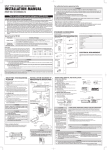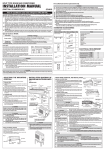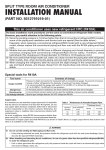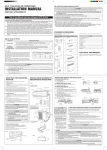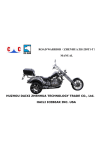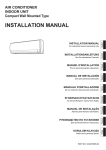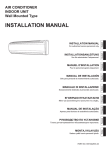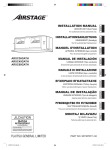Download INSTALLATION MANUAL
Transcript
SPLIT TYPE ROOM AIR CONDITIONER For authorized service personnel only. INSTALLATION MANUAL WARNING (1) For the room air conditioner to operate satisfactory, install it as outlined in this installation manual. (B09LD/B12LD) (PART No. 9314989018-02) This air conditioner uses new refrigerant HFC (R410A). The basic installation work procedures are the same as conventional refrigerant (R22) models. However, pay careful attention to the following points: (1) Since the working pressure is 1.6 times higher than that of conventional refrigerant (R22) models, some of the piping and installation and service tools are special.(See the table below.) Especially, when replacing a conventional refrigerant (R22) model with a new refrigerant R410A model, always replace the conventional piping and flare nuts with the R410A piping and flare nuts. (2) Models that use refrigerant R410A have a different charging port thread diameter to prevent erroneous charging with conventional refrigerant (R22) and for safety. Therefore, check beforehand.[The charging port thread diameter for R410A is 1/2 threads per inch.] (3) Be more careful that foreign matter (oil, water, etc.) does not enter the piping than with refrigerant (R22) models. Also, when storing the piping ,securely seal the opening by pinching ,taping, etc. (4) When charging the refrigerant, take into account the slight change in the composition of the gas and liquid phases, and always charge from the liquid phase side whose composition is stable. Tool name (7) Do not turn on the power until all installation work is complete. ● ● ● ● Be careful not to scratch the air conditioner when handling it. After installation, explain correct operation to the customer, using the operating manual. Let the customer keep this installation manual because it is used when the air conditioner is serviced or moved. The maximum length of the piping is 20 m. The maximum height difference of the piping is 15 m, if the units are further apart than these, correct operation can not be guaranteed. STANDARD ACCESSORIES Name and Shape Contents of change Pressure is high and cannot be measured with a conventional gauge. To prevent erroneous mixing of other refrigerants, the diameter of each port has been changed. It is recommended the gauge with seals-0.1 to 5.3 MPa (-1 to 53 bar) for high pressure. -0.1 to 3.8 MPa (-1 to 38 bar) for low pressure. To increase pressure resistance, the hose material and base size were changed. A conventional vacuum pump can be used by installing a vacuum pump adapter. Special gas leakage detector for HFC refrigerant R410A. Charge hose Vacuum pump Gas leakage detector (5) Also do not use an extension cord. (6) Plug in the power cord plug firmly. If the receptacle is loose, repair it before using the room air conditioner. The following installation accessories are supplied. Use them as required. Special tools for R410A Gauge manifold (2) Connect the indoor unit and outdoor unit with the air conditioner piping and cords available standards parts. This installation manual describes the correct connections using the standard accessories and the parts specified in this installation manual. (3) Have installation work done by authorized service personnel only. (4) Never cut the power cord, lengthen or shorten the cord, or change the plug. Copper pipes It is necessary to use seamless copper pipes and it is desirable Table 1 Thicknesses of Annealed Copper Pipes that the amount of residual oil is less than 40 mg/10m. Do not Thickness (mm) use copper pipes having a collapsed, deformed or discolored Nominal Outer diameter R410A [ref.] R22 portion (especially on the interior surface). Otherwise, the exdiameter (mm) pansion value or capillary tube may become blocked with 1/4 6.35 0.80 0.80 contaminants. 3/8 9.52 0.80 0.80 As an air conditioner using R410A incurs pressure higher than when using R22, it is necessary to choose adequate materials. Thicknesses of copper pipes used with R410A are as shown in Table1.Never us copper pipes thinner than 0.8mm even when it is available on the market. WARNING (1) Do not use the existing (for R22) piping and flare nuts. • If the existing materials are used, the pressure inside the refrigerant cycle will rise and cause breakage, injury, etc.(Use the special R410A materials.) (2) When installing and relocating the air conditioner, do not mix gases other than the specified refrigerant(R410A) to enter the refrigerant cycle. • If air or other gas enters the refrigerant cycle, the pressure inside the cycle will rise to an abnormally high value and cause breakage, injury, etc. Q’ty Wall hook bracket Name and Shape One set of following parts are necessary in istallation of this product. Name Q’ty Connection pipe assembly Cloth tape Connection cord 1 Wall pipe 1 Decorative tape Vinyl tape Wall cap Tapping screw (big) Remote control unit Saddle Drain hose Tapping screws 1 Battery 8 Sealant ELECTRICAL REQUIREMENT Tapping screw (small) 2 Remote control unit holder Always make the air conditioner power supply a special branch circuit and provide a special switch and receptacle. Do not extend the power cord. 2 Air-cleaning and Deodorizing filter 1 1 Drain pipe 1 CAUTION When installing pipes shorter than 3m, sound of the outdoor unit will be transferred to the indoor unit, which will cause large operating sound or some abnormal sound. SELECTING THE MOUNTING POSITION INSTALLATION DIAGRAM OF INDOOR AND OUTDOOR UNITS Fig. 2 Decide the mounting position with the customer as follows: 1. INDOOR UNIT (1) Install the indoor unit level on a strong wall which is not subject to vibration. (2) The inlet and outlet ports should not be obstructed : the air should be able to blow all over the room. (3) Install the unit near an electric outlet or special branch circuit. (4) Do not install the unit where it will be exposed to direct sunlight. (5) Install the unit where connection to the outdoor unit is easy. (6) Install the unit where the drain pipe can be easily installed. (7) Take servicing, etc. into consideration and leave the spaces shown in (Fig. 2). Also install the unit where the filter can be removed. [INDOOR UNIT] (1) If possible, do not install the unit where it will be exposed to direct sunlight. (If necessary, install a blind that does not interfere with the air flow.) (2) Do not install the unit where a strong wind blows or where it is very dusty. (3) Do not install the unit where people pass. (4) Take your neighbors into consideration so that they are not disturbed by air blowing into their windows or by noise. (5) Provide the space shown in Fig. 2 so that the air flow is not blocked. Also for efficient operation, leave open three of the four directions front, rear, and both sides. 6 cm or over 9 cm or over (Wall cap) Air-cheaning and Deodorizing filter Air filter Bearing Front panel Knob Screws (4 position) Front panel The fixing axle of the intake grille is installed on the Panel. Lay down the intake grille. Remove intake grille (Reference the intake grille removal.) Remove four screws. The thumb is hung on the lower part as shown in the figure, and it pulls to the front, pushing [ ] mark , and bottom hooks (two position) is removed from wall hook bracket. The front panel bottom is pulled to the front, and bottom hooks is removed indoor unit. The front panel is pulled to the front, raising the upper surface, and a front panel is removed. (4) Remote control unit holder (5) Push Push [ ] mark Front panel Wall hook bracket Top hole (center) Top hook (two sides) Top holes (two sides) Top hook (center) Front panel THE FRONT PANEL INSTALLATION (1) Firstly, fit the lower part of the front panel, and insert top and bottom hooks. (Three top sides, six bottom sides) Four screws is attached. The intake grille is attached. (2) (3) Tapping screw (small) Connection Cord Conform to Type245 IEC57 CAUTION [OUTDOOR UNIT] 10 cm or over Install the front panel and INTAKE GRILLE securely. If installation is imperfect, the front panel or INTAKE GRILLE may fall off and cause injury. 10 cm or over 25 cm or over 20 cm or over Be sure that the top hole of the front panel is hooked securely to the hook of the base. CUSTOMER GUIDANCE 5 cm or over Outdoor unit bottom Explain the following to the customer in accordance with the operating manual: (1) Starting and stopping method, operation switching, temperature adjustment, timer, air flow switching, and other remote control unit operations. (2) Air filter removal and cleaning, and how to use the air louvers. (3) Give the operating and installation manuals to the customer. Bottom hole (six position) Bottom hooks (six position) PUMP DOWN OPERATION (FORCED COOLING OPERATION) To avoid discharging refrigerant into the atmosphere at the time of relocation or disposal, recover refrigerant by doing the cooling operation or forced cooling operation according to the following procedure. (When the cooling operation cannot start in winter, and so on, start the forced cooling operation.). (1) Do the air purging of the charge hose by connecting the charging hose of gauge manifold to the charging port of 3 way valve and opening the low-pressure valve slightly. (2) Close the valve stem of 2 way valve completely. (3) Start the cooling operation or following forced cooling operation. When using the remote control unit Press the TEST RUN button after starting the cooling operation by the remote control unit. The operation indicator lamp and timer indicator lamp will begin to flash simultaneously during test run. When using the MANUAL AUTO button of the indoor unit (The remote control unit is lost, and so on.) Keep on pressing the MANUAL AUTO button of the indoor unit for more than 10 seconds. (The forced cooling operation cannot start if the MANUAL AUTO button is not kept on pressing for more than 10 seconds.) (4) Close the valve stem of 3 way valve when the reading on the compound pressure gage becomes 0.05~0 Mpa (0.5~0 kg/cm2). (5) Stop the operation. • Press the START/STOP button of the remote control unit to stop the operation. • Press the MANUAL AUTO button when stopping the operation from indoor unit side. (It is not necessary to press on keeping for more than 10 seconds.) CAUTION During the pump-down operation, make sure that the compressor is turned off before you remove the refrigerant piping. Do not remove the connection pipe while the compressor is in operation with 2 way or 3 way valve open. This may cause abnormal pressure in the refrigeration cycle that leads to breakage and even injury. WARNING 54 cm 32 cm (Rear) 5 Left outlet Indoor unit POWER Drain hose Fig. 3 (1) (2) (3) (4) NOTE: 4 Left rear outlet Intake grille Mounting shaft Open the intake grille. Pull down the knob. Lift the intake grille upward, until the axle at the top of the intake grille is removed. (1) (2) (3) The piping can be connected in the five directions indicated by 1, 2, 3, 4, and 5 in (Fig. 1). When the piping is connected in direction 2 or 5, cut along the piping groove in the side of the front cover with a hacksaw. When connecting the piping in direction 3, cut a notch in the thin wall at the front bottom of the front cover. 3 Bottom outlet Intake grille THE FRONT PANEL REMOVAL Dust collection unit • Do not directly install it on the ground, otherwise it will cause failure. 1 Rear outlet Grip PULL THE INTAKE GRILLE REMOVAL (1) (2) 150 cm or over CAUTION (1) Do not install where there is the danger of combustible gas leakage. (2) Do not install near heat sources. (3) If children under 10 years old may approach the unit, take preventive measures so that they cannot reach the unit. (4) Install the indoor unit on the wall where the height from the floors more than 230 cm. 2 Right outlet INSERT THE INTAKE GRILLE INSTALLATION 60 cm or over Fig. 1 (2) Pull the air cleaning unit grip in the direction of the arrow and remove the unit. (1) (2) (3) WARNING [Indoor unit piping direction] (1) Open the intake grille, and then remove the right air filter. (1) Open the intake grille, and then insert the dust collection unit into the indoor unit. (2) Install the right air filter, and then close the intake grille. 5 cm or over Remote control unit Install at a place that can withstand the weight of the indoor and outdoor units and install positively so that the units will not topple or fall. Fig. 4 AIR CLEANING UNIT REMOVAL AIR CLEANING UNIT INSTALLATION Wall hook bracket 230 cm or over 2. OUTDOOR UNIT FRONT PANEL REMOVAL AND INSTALLATION In places where the outdoor temperature drops to 0˚C or lower, the drain water may freeze and may stop up the drain or cause other outdoor unit trouble. Therefore take measures so that the drain water will not freeze and clog the drain. The rated voltage of this product is 230 V AC 50 Hz. Before turning on the power, check if the voltage is within the 220 V -10 % to 240 V +10 % range. Always use a special branch circuit and install a special receptacle to supply power to the room air conditioner. Use a circuit breaker and receptacle matched to the capacity of the air conditioner. (5) (6) (7) Do not extend the power cord. Perform wiring work in accordance with standards so that the air conditioner can be operated safely and positively. Install a leakage circuit breaker in accordance with the related laws and regulations and electric company standards. CAUTION (1) The power source capacity must be the sum of the air conditioner current and the current of other electrical appliances. When the current contracted capacity is insufficient, change the contracted capacity. (2) When the voltage is low and the air conditioner is difficult to start, contact the power company the voltage raised. Installation instruction on the back. INDOOR UNIT ● ● CUTTING THE HOLE IN THE WALL FOR THE CONNECTING PIPING (1) Cut a 65 mm diameter hole in the wall at the position shown in (Fig. 5). (2) When cutting the wall hole at the inside of the wall hook bracket, cut the hole within the range of the left and right center marks 40 mm below the wall hook bracket. When cutting the wall hole at the outside of the wall hook bracket, cut the hole at least 10 mm below over. (3) Cut the hole so that the outside end is lower (5 to 10 mm) than the inside end. (4) Always align the center of the wall hole. If misaligned, water leakage will occur. (5) Cut the wall pipe to match the wall thickness, stick it into the wall cap, fasten the cap with vinyl tape, and stick the pipe through the hole. (The connection pipe is supplied in the installation set.) (Fig. 5) (6) For left piping and right piping, cut the hole a little lower so that drain water will flow freely. (Fig. 5) Wall hook bracket Fig. 5 ● Lower Lower Connection pipe (6.35 mm dia.) Bend (R70) with a pipe bender Align the marks. Connection pipe (9.52 mm dia.) Indoor unit 65 mm dia. hole Indoor unit Wall hook bracket (Wall pipe) (Wall cap) (Inside) Wall (Outside) CONNECTING THE PIPING Fig. 6 Hook Tighten with two wrenches. Fig. 9 (1) Install the outdoor unit wall cap (supplied with the optional installation set or procured at the site) to the wall pipe. (2) Connect the outdoor unit and indoor unit piping. (3) After matching the center of the flare surface and tightening the nut hand tight, tighten the nut to the specified tightening torque with a torque wrench. (Table 2) Tapping screw String Install the wall hook bracket horizontally and perpendicularly. FORMING THE DRAIN HOSE AND PIPE Wrench (fixed) Flare nut Torque wrench Check if [L] is flared uniformly and is not cracked or scratched. (1) Cut the connection pipe to the necessary length with a pipe cutter. (2) Hold the pipe downward so that cuttings will not enter the pipe and remove the burrs. (3) Insert the flare nut onto the pipe and flare the pipe with a flaring tool. Table 2 Flare nut tightening torque Flare nut 15.7 to 17.6 N • m (160 to 180 kgf • cm) 29.4 to 41.1 N • m (300 to 420 kgf • cm) 9.52 mm dia. Table 3 A Clutch type Wing nut type 1.0 to 1.5 1.0 to 1.5 1.5 to 2.0 1.5 to 2.0 CAUTION Fig. 7 (1) Fasten a flare nut with a torque wrench as instructed in this manual. If fastened too tight, the flare nut may be broken after a long period of time and cause a leakage of refrigerant. Pipe (top) Rear piping Bottom piping Indoor unit drain hose (bottom) When installing indoor unit's drain hose outdoors, necessary measure for frost protection should be taken to prevent drain water frozen. • Under low temperature environment (when outdoor temperature under 0 °C), after cooling operation is executed, water in the drain hose could be frozen. Once drain water is frozen, the drain hose will be blocked and water leakage may be resulted for indoor unit. Removal method of drain Installation method of hose drain hose ● Remove the screw at the left of drain hose and pull out drain hose. Screw Drain hose ● Screw hole Drain fixture (blue) Drain hose Drain cock ● Be sure to install around the drain hose connector. ● As the screw is inside, be sure to use screwdriver treated with magnet. Square hole Screw Screw CAUTION (1) Match the terminal block numbers and connection cord colors with those of the outdoor unit. Erroneous wiring may cause burning of the electric parts. (2) Connect the connection cords firmly to the terminal block. Imperfect installation may cause a fire. (3) Always fasten the outside covering of the connection cord with the cord clamp. (If the insulator is chafed, electric leakage may occur.) (4) Securely earth the power cord plug. (5) Do not use the earth screw for an external connector. Only use for interconnection between two units. Fig. 11 Control box Fig. 13 Earth screw 5mm 12mm 12mm 5mm 30mm Set the unit on a strong stand, such as one made of concrete blocks to minimize shock and vibration. Do not set the unit directly on the ground because it will cause trouble. Remove the outdoor unit connector cover. Bend the end of the cord as shown in the figure. Connect the end of the connection cord fully into the terminal block. Fasten the sheath with a cord clamp. Install the connector cover. 45mm (1) (2) (3) (4) (5) Connector cover removal ● Insert the tab into the square hole of the indoor unit and fasten with a screw. Connection cord OUTDOOR UNIT WIRING OUTDOOR UNIT INSTALLATION ● Tab Connection cord Screw OUTDOOR UNIT ● Cord clamp (There is a terminal block inside.) Vertically insert the drain hose toward the inside, so that the drain fixture (blue) can accurately align with the screw hole around the drain cock. After inserting and before replacing, please reinstall and fix the removed screws. Drain fixture (blue) Cord clamp 5 mm 12 mm Drain cap Fig. 10 40 mm Remove the drain cap by pulling at the projection at the end of the cap with pliers, etc. (3) Connect the end of the connection cord fully into the terminal block. (4) Fasten the connection cord with a cord clamp. 5 mm Indoor unit drain hose INDOOR UNIT WIRING (1) Remove the cord clamp. (2) Bend the end of the connection cord as shown in the figure. 12 mm For left outlet piping, cut off the piping outlet cutting groove with a hacksaw. 50 mm Interchange the drain cap and the drain hose. (5) Prevent drain water frozen under low temperature environment. (2) During installation, make sure that the refrigerant pipe is attached firmly before you run the compressor. Do not operate the compressor under the condition of refrigerant piping not attached properly with 2-way or 3-way valve open. This may cause abnormal pressure in the refrigeration cycle that leads to breakage and even injury. Bind with vinyl tape Right piping [For Left rear piping, Left piping] CAUTION (1) In order to align the drain hose and drain cap, be sure to insert securely and vertically. Incline insertion will cause water leakage. (2) When inserting, be sure not to attach any material besides water. If any other material is attached, it will cause deterioration and water leakage. (3) After removing drain hose, be sure not to forget mounting drain cap. (4) Be sure to fix the drain hose with tape to the bottom of piping. A (mm) Conventional (R22) flare tool 0 to 0.5 0 to 0.5 [Rear piping, Right piping, Bottom piping] ● ● Arm strength Flash tool for R410A, clutch type ø 6.35 mm (1/4”) ø 9.52 mm (3/8”) Pipe Wrist strength Pipe outside diameter Pipe outside diameter Die Tightening torque standard (using a 20 cm wrench) Tightening torque 6.35 mm dia. Insert the flare nut (always use the flare nut attached to the indoor and outdoor units respectively) onto the pipe and perform the flare processing with a flare tool. Use the special R410A flare tool, or the conventional (for R22) flare tool. When using the conventional flare tool, always use an allowance adjustment gauge and secure the A dimension shown in table 3 . To prevent gas leakage, coat the flare surface with refrigerator oil. Connection pipe Indoor unit pipe FLARING CAUTION Install the indoor unit piping in the direction of the wall hole and bind the drain hose and pipe together with vinyl tape. (Fig. 7) Install the piping so that the drain hose is at the bottom. Wrap the pipes of the indoor unit that are visible from the outside with decorative tape. Bottom hooks CONNECTION Center notch Wall hook bracket (Fitting) Wall hook bracket After hooking the indoor unit to the top hook, hook the fittings of the indoor unit to the two bottom hooks while lowering the unit and pushing it against the wall. (Spacer) WARNING ● Top hooks Hang the indoor unit from the hooks at the top of the wall hook bracket. Insert the spacer, etc. between the indoor unit and the wall hook bracket and separate the bottom of the indoor unit from the wall. 10 mm or over Wall hook bracket If the wall pipe is not used, the cord interconnecting the indoor and outdoor units may touch metal and cause electric leakage. Fig. 8 [Installing the indoor unit] ● ● 5 to 10 mm low Fasten with vinyl tape INSTALLING THE WALL HOOK BRACKET (1) Install the wall hook bracket so that it is correctly positioned horizontally and vertically. If the wall hook bracket is tiled, water will drip to the floor. (2) Install the wall hook bracket so that it is strong enough to withstand the weight of an adult. ● Fasten the wall hook bracket to the wall with 6 or more screws through the holes near the outer edge of the bracket. ● Check that there is no rattle at the wall hook bracket. Center mark 65 mm dia. hole For left piping and left rear piping, align the marks on the wall hook bracket and shape the connection pipe. Bend the connection piping at the bend radius of 70 mm or more and install no more than 35 mm from the wall. After passing the indoor piping and drain hose through the wall hole, hang the indoor unit on the hooks at the top and bottom of the wall hook bracket. Control box cover Remove the tapping screws. Installing the connector cover Cord clamp (1) After inserting the two front hooks, then insert the rear hook. (2) Tighten the tapping screws. Connection cord Connection cord wiring WARNING Tapping screw (1) Install the unit where it will not be tilted by more than 5°. Rear hooks Front hooks (2) When installing the outdoor unit where it may exposed to strong wind, fasten it securely. Run the connection cord to the rear of the outdoor unit within the A range of the arrows shown in the figure. (The connector cover becomes difficult to install.) Cord clamp Sheath Earth screw Indoor unit terminal block Earth screw Outdoor unit terminal block Connection cord Fig. 14 Connector cover AIR PURGE (1) Refrigerant must not be discharged into atmosphere. Close the high pressure side valve of the gauge manifold fully and do not operate it during the following work. (2) After connecting the piping , check the joints for gas leakage with gas leak detector. 1. Check if the piping connections are secure. 2. Check that the stems of 2-way valve and 3-way valve are closed fully. 3. Connect the gauge manifold charge hose to the charging port of the 3-way valve (side with the projection for pushing in the valve core). 4. Open the low pressure side valve of the gauge manifold fully. Connection cord CAUTION Always use a vacuum pump to purge the air. Refrigerant for purging the air is not charged in the outdoor unit at the factory. 10. Fully open the valve stems of the 2-way valve and 3-way valve using a hexagon wrench. (After the valve stem begins to turn, turn it with a torque of less than 2.9 N • m (30 kgf • cm) until it stops turning.) 11. Firmly tighten the 2-way valve and 3-way valve blank cap and the charging port cap. Fig. 12 5. Operate the vacuum pump and start pump down. 6. Slowly loosen the flare nut of the 3-way valve and check if air enters, then retighten the flare nut. (When the flare nut is loosened the operating sound of the vacuum pump changes and the reading of the compound pressure gauge goes from minus to zero.) 7. Pump down the system for at least 15 minutes, then check if the compound pressure gauge reads -0.1 MPa (-76 cmHg, -1 bar). CAUTION (1) Match the terminal block numbers and connection (3) Always fasten the outside covering of the connection cord with the cord clamp. (If the insulator is cord colors with those of the indoor unit. chafed, electric leakage may occur.) Erroneous wiring may cause burning of the electric parts. (4) Securely earth the power cord plug. (2) Connect the connection cords firmly to the terminal (5) Do not use the earth screw for an external connector. block. Imperfect installation may cause a fire. Only use for interconnection between two units. FINISHING (1) Insulate between pipes. ● For rear, right, and bottom piping, overlap the connection pipe heat insulation and indoor unit pipe heat insulation and bind them with vinyl tape so that there is no gap. ● For left and left rear piping, butt the connection pipe heat insulation and indoor unit pipe heat insulation together and bind them with and vinyl tape so that there is no gap. ● For left and left rear piping, wrap the area which accommodates the rear piping housing section with cloth tape. ● For left and left rear piping, bind the connection cord to the top of the pipe with vinyl tape. ● For left and left rear piping, bundle the piping and drain hose together by wrapping them with cloth tape over the range within which they fit into the rear piping housing section. (2) Temporarily fasten the connection cord along the connection pipe with vinyl tape. (Wrap to about 1/3 the width of the tape from the bottom of the pipe so that water does not enter.) (3) Fasten the connection pipe to the outside wall with saddles, etc. (4) Fill the gap between the outside wall pipe hole and the pipe with sealer so that rain water and wind cannot blow in. (5) Fasten the drain hose to the outside wall, etc. Fig. 15 Fig. 16 Indoor unit pipe (heat insullation) Vinyl tape Bind the pipes together so that there is no gap. Pipe Wrap with cloth tape Drain hose Left piping Cloth tape For connection from the left rear Connection cord Connection cord Wall pipe Connection pipe Drain hose Pipe Drain hose Check the following: (Outside wall cap) (Saddle) Overlap the insulation Connection pipe (heat insulation) GOOD (Sealer putty) BAD BAD Lifted up Wave BAD Drain hose Saddle Wall 8. At the end of pump down, close the low pressure side gauge of the gauge manifold fully and stop the vacuum pump. 9. Slowly loosen the valve stem of the 3-way valve. When the compound pressure gauge reading reaches 0.1-0.2 MPa, retighten the valve stem and disconnect the charge hose from the 3-way valve charging port. (If the stem of the 3-way valve is opened fully before the charge hose is disconnected, it may be difficult to disconnect the charge hose.) Additional charge Refrigerant suitable for a piping length of 15 m is charged in the outdoor unit at the factory. When the piping is longer than 15 m, additional charging is necessary. For the additional amount, see the table below. Table 5 Pipe length 15 m 20 m Additional refrigerant None 100 g Pipe (Outdoors) End in water TEST RUNNING Table 4 Tightening torque Blank cap 19.6 to 24.5 N • m (200 to 250 kgf • cm) Charging port cap 12.3 to 15.7 N • m (125 to 160 kgf • cm) CAUTION (1) When adding refrigerant, add the refrigerant from the charging port at the completion of work. (2) The maximum length of the piping is 20 m. If the units are further apart than this, correct operation can not be guaranteed. Between 15 m and 20 m, when using a connection pipe other than that in the table, charge additional refrigerant with 20g/1 m as the criteria. ● Perform test operation and check items 1 and 2 below. ● For the test operation method, refer to the operating manual. ● The outdoor unit, may not operate, depending on the room temperature. In this case, press the test run button on the remote control unit while the air conditioner is running, (Point the transmitter section of the remote control unit toward the air conditioner and press the test run button with the tip of a ball-point pen, etc.) ● To end test operation, press the remote control unit START/STOP button. (When the air conditioner is run by pressing the test run button, the OPERATION indicator lamp and TIMER indicator lamp will simultaneously flash slowly.) 1. INDOOR UNIT (1) (2) (3) (4) Is operation of each button on the remote control unit normal? Does each lamp light normally? Do the air flow-direction louver operate normally? Is the drain normal? Fig. 17 Transmitter section 2. OUTDOOR UNIT (1) Is there any abnormal noise and vibration during operation? (2) Will noise, wind, or drain water from the unit disturb the neighbors? (3) Is there any gas leakage? Test run button P/N 9314989018-02


